OrganoClay Products / MCM 830P
Facts About Ecologix MCM-830P Pure OrganoClay
- MCM-830P is made from calcined palygorskite clay. Unlike the flake-like crystals of Na-bentonite, palygorskite's needle-shaped crystalline structure is inert and nonswelling (this is also the difference between "clumping" and "non-clumping" kitty litters).
- MCM-830P safe pH operating range is 4-11. Waters with a pH out of range may deteriorate the clay.
- MCM-830P is safe at temperatures up to 175 F. Temperatures above this may deteriorate the clay.
- MCM-830P A 5-micron filter must be used ahead of MCM-830P to prevent solids from plugging the media bed.
- MCM-830P OrganoClay is 40% heavier in weight than activated carbon
- OrganoClay weighs 42 lbs. per cubic foot of media / Activated Carbon weighs 28 lbs. per cubic foot of media
| Mesh
Conversion Table | Activated Carbon Ecologix
OrganoClay - MCM-830P is a modified clay mineral
designed for use as a filter media in process
and wastewater treatment. The product effectively
removes a wide range of hydrocarbons and trace
amounts of heavy metals from water. Unlike competitive
filter media, Ecologix OrganoClay - MCM-830P does
not swell or blind when sorbing contaminants,
so it need not be blended with anthracite filler. The main difference between Ecologix OrganoClay - MCM-830P and other organoclays is that our media is 100% non-swelling modified clay and does not require blending with anthracite for porosity in a filter bed. This means that filter beds typically run 2-3x longer than filters using competitive (30/70 and 40/60 - clay/anthracite blends). In addition, because Ecologix OrganoClay - MCM-830P has a greater amount of "actives," it may also remove contaminants present at lower levels better than competitive medias. |
|
||||||||||||||
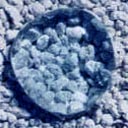 |
MCM-830P
OrganoClay is a powerful, selective adsorbent that
will recognize hydrocarbons and other pollutants
- but not water. Designed for use in conventional
liquid-phase filtration vessels, the granular modified
clay attracts contaminants like a magnet and locks
them in its molecular structure.
MCM-830P Modified Clay Media is produced in a proprietary process by combining sodium montmorillonite clay with a cationic quaternary amine salt, which replaces adsorbed sodium by ion exchange. Resulting clay surfaces become organophilic. Extensive application use and field testing of MCM-830P Modified Clay Media technology, verified by independent laboratories, has demonstrated removal of a wide range of contaminants to discharge levels which meet NPDES and other regulatory requirements. |
Why OrganClay is the best - Product Comparison
| Dry Product | Products After Being Wet | ||||||
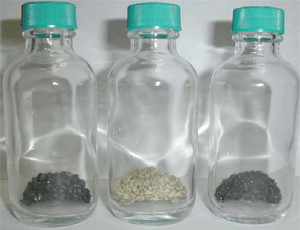 |
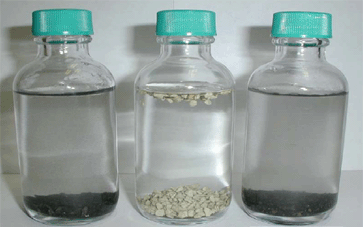 |
||||||
|
|||||||
| Products After Adding Oil | Products After Being Mixed | ||||||
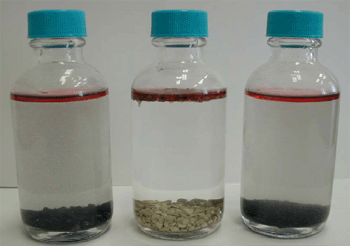 |
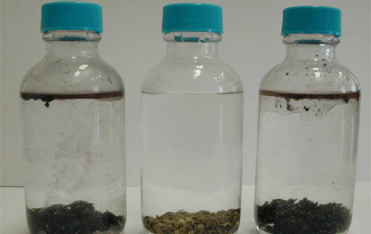 |
||||||
|
|||||||
Observations
Although this test does not exactly
simulate large-scale column operation of organoclays,
the sorption characteristics of the various products
can be seen. Ecologix OrganoClay - MCM-830P clearly
outperforms the competitive products by quickly
and efficiently removing nearly all of the paraffin
oil from the water.
Ecologix OrganoClay - MCM-830P
may be applied as a stand-alone filter media,
to post-treat the effluent of oil-water separators,
DAFs, clarifiers, and sand filters, or to pretreat
the influent of GAC filters, reverse osmosis units,
and ultra filtration devices. When properly applied,
the Ecologix OrganoClay - MCM-830P is versatile,
efficient, and cost-effective.
This
advantage is due to the fact that Ecologix OrganoClay
- MCM-830P is a nonswelling 100% active modified
media, rather than a 30-40% clay product that
must be blended with anthracite for porosity.
This nonswelling characteristic also means that
spent Ecologix OrganoClay - MCM-830P does not
become “mushy” and is easily handled
for disposal. You use OrganoClay as a pre-polisher for activated
carbon to remove traces of oil from water, you will
not only get superior results, but superior savings.
OrganoClay is approved by the National Defense Department.
OrganoClay
is a cost-saving filtration media -
When used alone,
OrganoClay removes oil at 700% the rate of activated
carbon and will reduce your operating costs by 50%
or more. When used as a pre-treatment for activated
carbon in applications involving oil and grease
removal, OrganoClay removes the oil and grease effectively,
allowing the activated carbon to remove the soluble
organic compounds more efficiently.
OrganoClay
increases the efficiency of the treatment process -
The quarternary amine-treated clay pellets
have the ability to capture 50 - 60% of their weight
in oil, grease and other low solubility organic
compounds. Used upstream from activated carbon or
downstream of other oil removal processes, OrganoClay
optimizes the overall system performance and reduces
costs.
Stand
Alone:
OrganoClay outperforms anthracite, GAC, and all
other filter media technologies in stand-alone applications
for the removal of higher molecular weight hydrocarbons.
Post Treatment:
OrganoClay may be applied downstream of oil/water
separators, DAF systems, clarifiers, sand filters,
and other physical/chemical separation systems.
Application
OrganoClay is designed for column
operation. The media should be placed in appropriately
sized fluid contactor vessels in the same manner
as granular activated carbon (GAC). OrganoClay needs
to be wetted and deaerated with clean water for
a minimum of 1 hour prior to the introduction of
contaminants in order to prevent fluid channeling
within the media bed.
Pretreatment:
OrganoClay may be used to pretreat the influent
of GAC filters, reverse osmosis units, ultra filtration
units, and other related systems where less soluble,
higher molecular weight hydrocarbons tend to cause
plugging, fouling, and equipment contamination.
Dosage
The amount of OrganoClay required will vary depending
on contaminant concentration and type, contact time,
and fluid temperature. Generally, contaminants with
lower concentrations and solubilities, longer contact
times, and moderate fluid temperatures are preferred.
Ecologix OrganoClay - EOC85 will typically absorb
40-70% of its own weight in hydrocarbons, dependent
upon the conditions described above.
Storage
and Handling
Store in a dry place. Avoid extreme temperatures.
Avoid breathing dust. If clothing becomes dusty,
launder before using.
Backwashing and Backwash
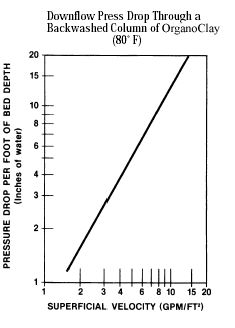 |
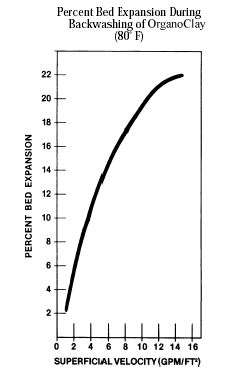 |
|
||||||||||||||||||||||
Hydrocarbon Removal with Modified Clay Media (OrganoClay)
MCM-830P completely removes free hydrocarbons from wastewater and also removes dissolved hydrocarbons including benzene, toluene, ethylbenzene, and xylene (BTEX). When used in conjunction with a polishing stage of granular activated carbon, Modified Clay Media removes dissolved and free hydrocarbons to levels well below current water quality standards.
Our MCM-830P OrganoClay product can be used to effectively remove oil and other hydrocarbons from water where traditional oil-water separators have had limited success. The product does not absorb hydrocarbons, but rather adsorbs them, which leaves no byproduct from the process. In the adsorbtion process, the quaternary amines create organic pillars between the clay platelets that increase the interlamellar distance and facilitate the formation of a hydrocarbon partition.
Water Treatment
When used for water treatment, organoclay is commonly
utilized in the upstream sector of the petroleum
industry for removing hydrocarbons from refinery
process water, but is rarely used in the production
of petroleum. Many other industries also use organoclay,
including shipping and dockside servicing, car
washes, and other businesses that deal with an
oily wastewater stream. OrganoClays have also
been tested for treating ground and surface water
for other organic chemicals such as PCBs and pesticides.
Field testing and project implementation have
consistently revealed that the combination of
MCM-830P and granular activated carbon effectively
removed hydrocarbons from produced water. Treated
in field testing revealed specific findings:
- Reduces Total Petroleum Hydrocarbons to non-detectable levels. Sampling reveals TPH below detectable limits after adsorption by MCM-830P.
- Reduces Oil and Grease to non-detectable levels. Samples show Oil and Grease below detectable limits after adsorption by MCM-830P alone.
- Reduced soluble hydrocarbons Benzene, Ethylbenzene, Toluene, and Xylene to barely detectable levels. In samples BTEX was barely detectable after adsorption by MCM-830P alone. BTEX was below detectable limits after the combination of MCM-830P and granular activated carbon.
In simple terms, MCM-830P eliminated hydrocarbon
contamination from produced water during the test.
Other testing has shown that similar results are
consistent in large-scale commercial applications.
Effective Water
Treatment with Minimal Cost
Other laboratory testing of spent MCM-830P has
shown that BTEX and other volatile hydrocarbons
are adsorbed tightly enough for the spent product
to pass the EPAs Toxicity Characteristic Leachate
Procedure (TCLP) test and be disposed as a non-hazardous
waste. The TCLP is used to identify the presence
or absence of toxic chemicals that might be able
to leach into groundwater after disposal. Being
classified as a non-hazardous waste may allow
the spent product to be landfilled, land farmed,
or otherwise disposed in an economical and ecologically
proper manner.


